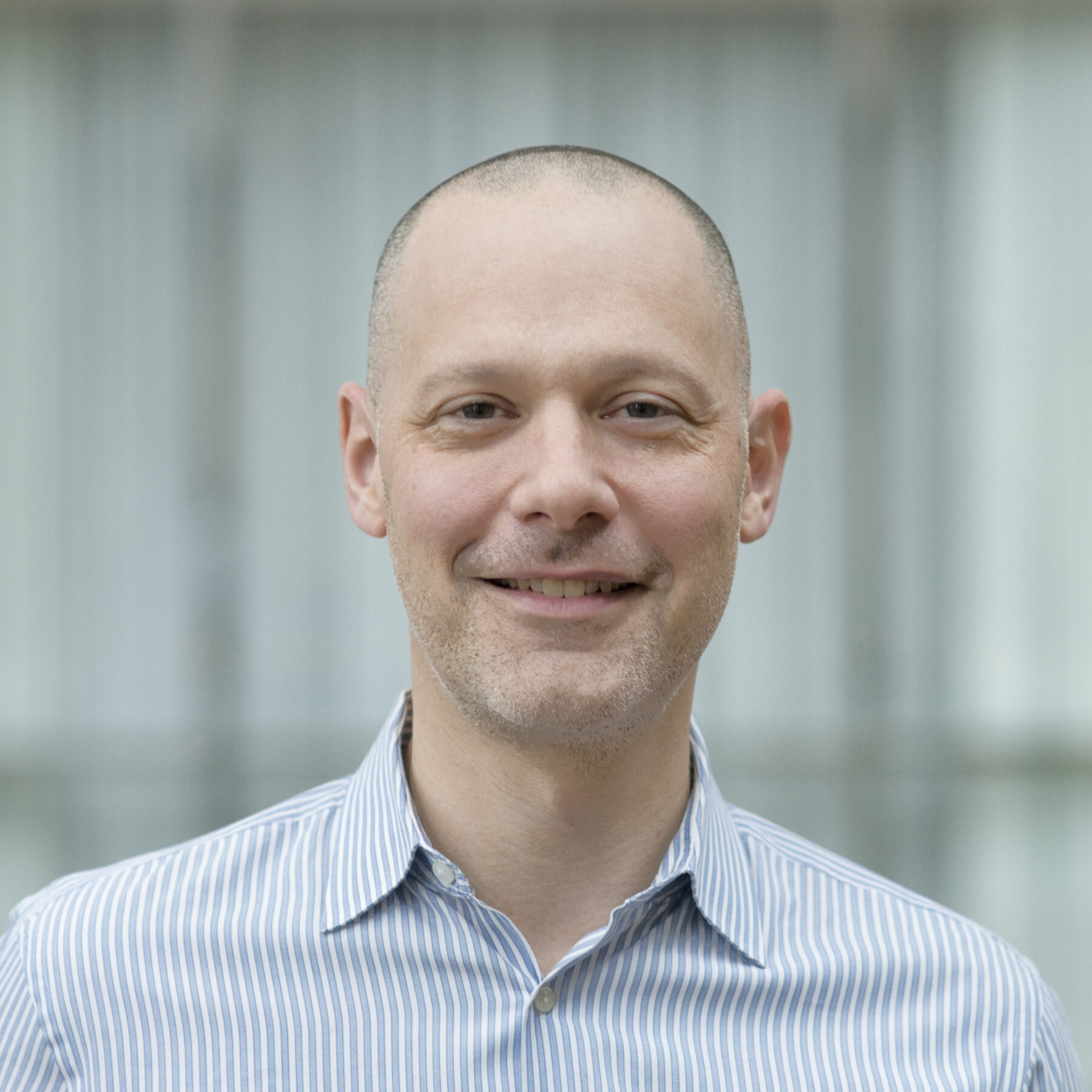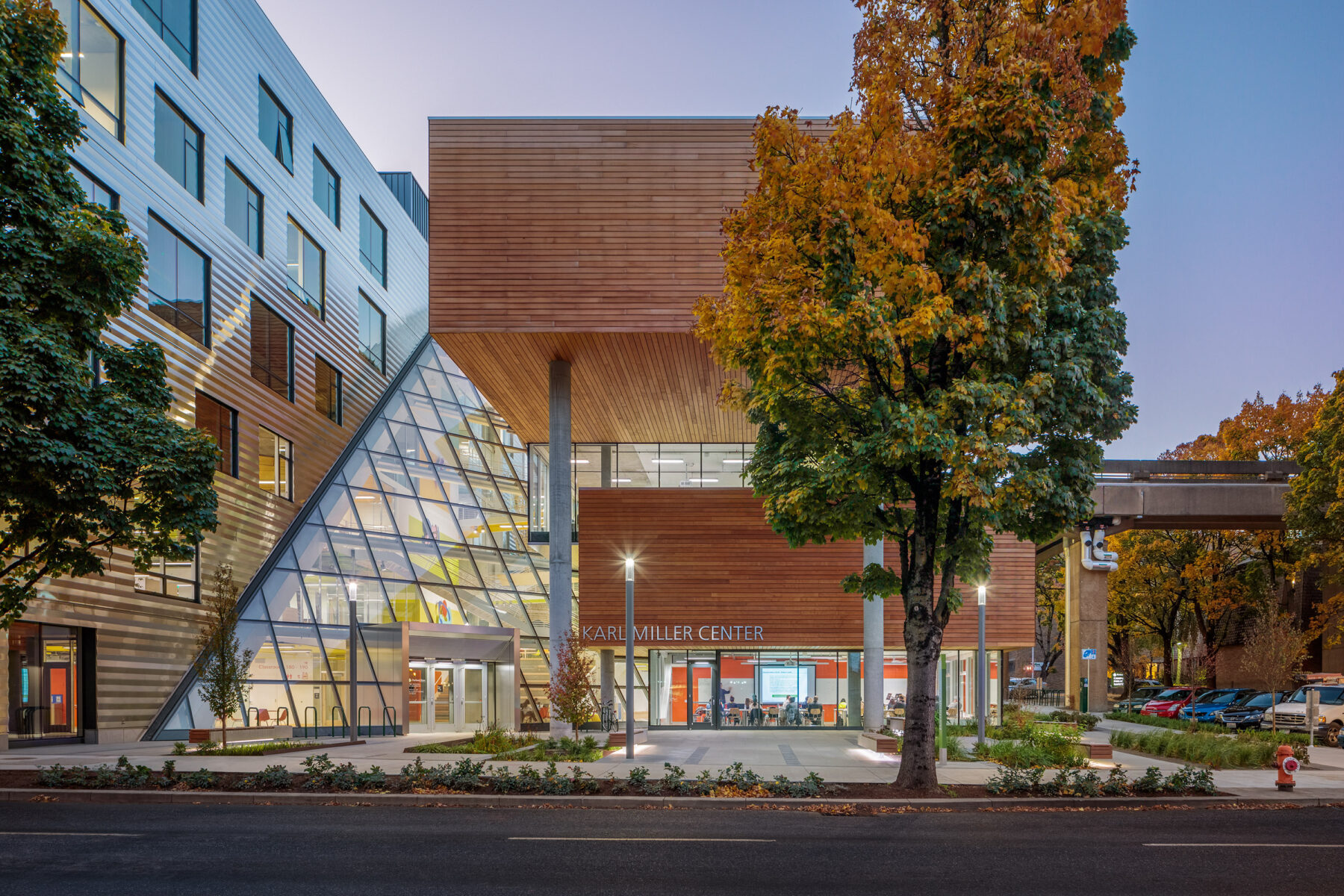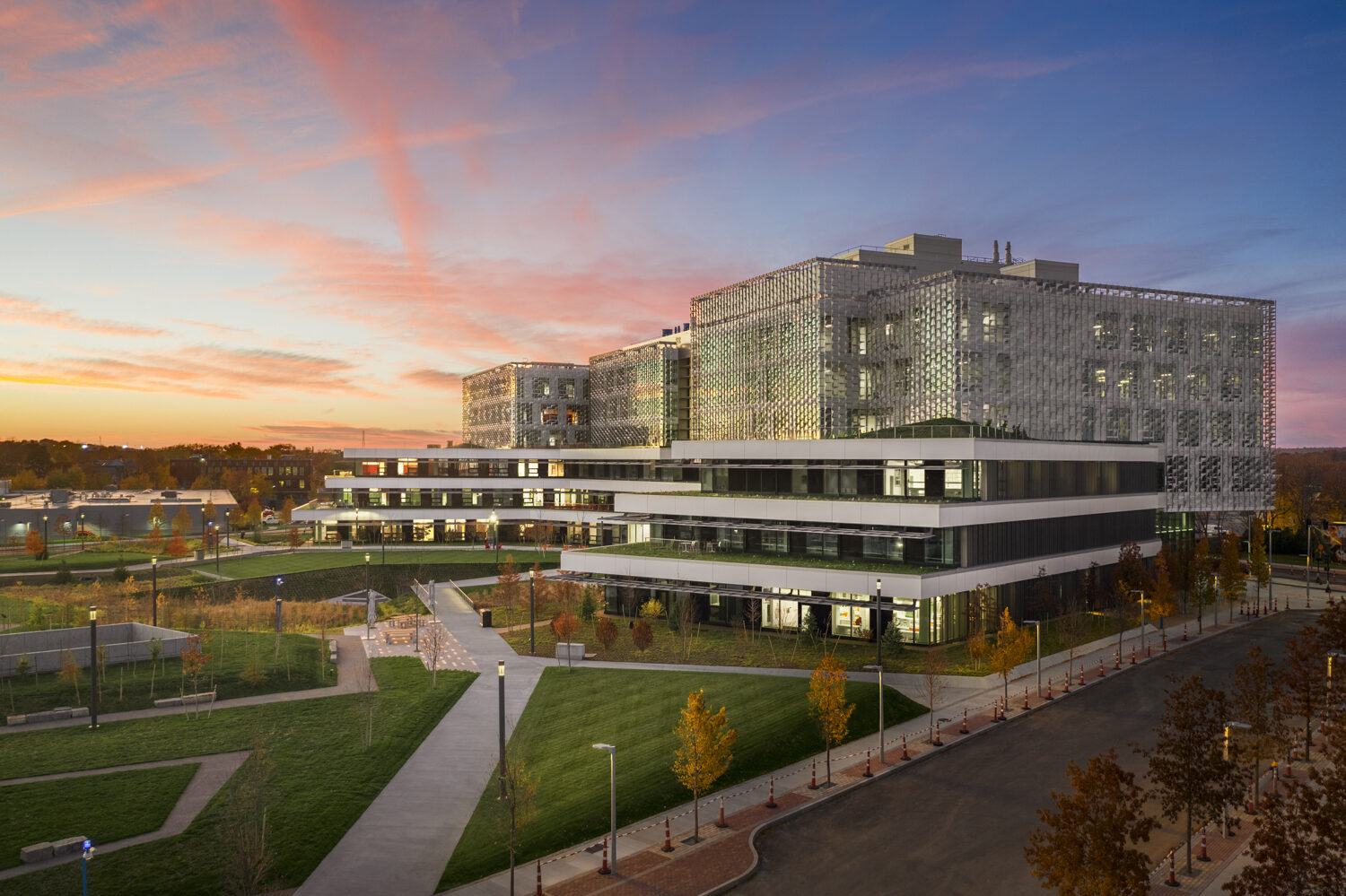Robert Noblett FAIA

Partner, Behnisch Architekten
2022 AIA College of Fellows inductee
When did you first become interested in architecture as a possible career?
As I recall, a friend of my father’s was an architect with his own firm in the place I lived at the time. He had a very unusual house on a lake, with Eames furniture, lots of filled bookshelves, and probably an expensive car. I already enjoyed drawing made-up plans of fantasy houses and building models, and I must have thought that if being an architect could lead to that kind of lifestyle, I would like to do it.
Who or what deserves credit for your success?
It is always hard to isolate an event or series of events from the ones that preceded it, but after finishing my Bachelor’s degree I had decided to accept admission to Columbia for my Master’s degree. Several of my classmates from UofI had already been studying at MIT for a year or so, and on my way to visit Columbia I stopped to visit them in Boston. During that short weekend, everything changed. I decided I would be going to MIT, and that decision changed everything. In addition to it resulting in my meeting my future wife (also an architect), nearly every professional or personal opportunity flowed from that one decision.
Who do you think is the most underappreciated architect and why?
I have always wondered why the buildings designed by the Argentinian architect Eladio Dieste were not more broadly known and shared. I only became aware of them when my former thesis advisor, Stanford Anderson, organized an exhibition of his work at MIT. I later found a compendium of his work at an old bookstore in Madrid, complete with the structural calculations he used for his so-called Catalan vaults. Technically and formally, these were fascinating structures that perhaps were not more widely disseminated because they did not come from a media-rich environment.
What is your favorite Boston-area building or structure?
Peabody Terrace and the MIT Chapel.
Has your career taken you anywhere you didn’t expect?
I would never have expected to be working in a German firm, to say nothing of establishing its US office successfully.
Which one of your current projects excites you the most?
We were commissioned a few years ago by the University of Toronto to design a parking structure for their Scarborough campus. They initially hired us because they intended to essentially clad a normal steel or precast concrete parking structure with some kind of sexy façade. We proposed that a far more meaningful approach would be to build this piece of infrastructure out of mass timber and demonstrate a very low-carbon way (and probably the only responsible way) to build such a facility for 2000 fossil-fuel burning cars. Our client there was very enthusiastic about the idea and has supported us throughout the long and arduous process of figuring this out technically and getting it permitted by the authorities in Ontario. It is rewarding to work on a project where the ethical dimension of the design, and the influence that thoughtful design can make in terms of the planetary impact of the project, is valued above purely prosaic and economic concerns, especially for what is essentially a piece of infrastructure.
What has been your most proud moment as an architect/designer?
I think I tend to feel most proud when I see the results of our collective work come to fruition successfully, meaning that our group of architects and designers here in the office work together and achieve the desired result. Sometimes that is winning a new project together, sometimes it is going to see a completed project that we all worked on together. But I think the pride comes from seeing a process that we work so hard to protect bear fruit, in big but also sometimes small ways.
What do you hope to contribute from your work?
I am always interested in innovation and not doing things the way they have been done 1000 times before. But I hope that the work we do and the kinds of projects we realize help, in some way, to move the needle of the profession writ large, so we are able to demonstrate that there are alternatives to the business-as-usual approach to making buildings.
If you could collaborate with anyone in the profession, who would it be and why?
Our office has always skewed very young in terms of its demographics, and is geographically and culturally quite diverse. I have been constantly amazed by the quality of so many young people’s thinking and design skills, in particular when they have not yet been ground down by some of the profession’s more tiresome aspects. I think the person with whom I would most like to collaborate is the next one who is coming, who I don’t yet know, but who will re-energize my faith in design.
Have you won any award(s) from the BSA or another establishment? What elements from that project would you like to see shape the future of the profession?
A few years ago we won an Honor Award for our Karl Miller Center project at Portland State University in Portland, Oregon. It is an all passively-cooled (no air-conditioning) building that, although built in a somewhat more benign climate, is a great example of what we can do given a supportive client who takes the urgency of our climate crisis seriously.
What does equity mean to you?
I tend to take a fairly broad view of equity when it comes to our profession. So much of what we do as professionals in the design and construction industry touches on the issue of fairness and inclusion that I find it remarkable we have only started talking seriously about it in the last five years or so. Internally to the profession, equity has to do with access to opportunity and stakeholding for people from all walks of life—race, gender, socioeconomic background—to participate fully and benefit from all the profession has to offer. The quota systems that have been in place for many years are a start, but these are too often taken as minimums to be fulfilled, not as opportunities to build careers and practices that can eventually compete with more traditional, established firms.
But equity goes far beyond that and extends to the ethics of how our services as professionals and the product of our efforts are distributed and enjoyed globally. Without knowing the exact statistics, I would feel very comfortable assuming that the vast majority of what constitutes architectural production worldwide is highly concentrated in the so-called first world—measured in particular by carbon emissions, both embodied and operational. Access to housing, to transportation, and to infrastructure is radically imbalanced and seems to continually worsen in this regard, and is as such another area in which we have a lot of work to do as a profession.

What do you see as the largest barrier to equity in your profession?
Presumably, the inertia of running an architectural practice within a complex and fast-moving industry that is highly resistant to innovation or change is a huge barrier to changing the equity equation. In terms of opening up the opportunities within the profession we are doing better, but I’m not sure that the architectural ‘establishment’ is really ready to watch their profits sink in order to make more room for a more diverse field of competitors.
But even the establishment is changing from within, with staffs and ownership clearly diversifying. At the global scale the answer is probably far more complex, having to do with geopolitical history, distribution of resources, and the structural resistance to real change that all of that entails, however I remain convinced that there is no real solution that does not entail a certain redistribution of carbon wealth from richer societies to poorer ones.
What are some changes that you have implemented in your firm (or for yourself) to address issues of equity in your profession?
It is important to me that we don’t just pay lip service to the topic of equity. It should not be a box-checking exercise, and simply meeting minimum participation percentages does not address the fundamental change that is needed. Within our firms, and within the teams that we build to deliver complex, technical projects, we have to implement strategies that empower underrepresented professionals to compete on equal footing with the more established firms. This means creating ownership opportunities for historically underrepresented architects. This means actively seeking out and hiring people from disadvantaged communities and conflict zones. This means integrating underrepresented professionals on design teams in ways that give them exposure to project types and decision-makers that they otherwise would not have access to.
We are active in all three of these areas currently. We recently elevated three new female architects to our partnership; we currently employ architects and designers from over 22 separate countries, more than half of whom are also female; and we are actively structuring our design teams in ways that create access for our partners, such that after completing one or two of these types of projects, they could realistically apply for and deliver them on their own.
What is the most effective step you’ve taken in your work toward a more sustainable built environment?
We have worked for the past 17 years to help people think more critically about what comfort means and how we can, on one hand, re-define the parameters of comfort, and on the other, propose alternative ways to achieve comfort that rely less and less on cooling systems that use tremendous amounts of non-renewable energy. Although we have achieved great successes in this regard, it still feels like the road ahead of us is longer than the one behind us. I still feel like people regard comfort as a kind of inalienable right in North America, and although technological development offers some hope in this regard, the fact is that until we face the issue of global equity in terms of comfort head-on, we are unlikely to deal with the climate crisis fully.
What policy from another city sets an example you think Boston could successfully follow?
Bern, Switzerland—they have banned all cars in the inner city.
What do you see as the largest barrier to a zero-waste building, city, and world?
I think this gets back to the question of comfort—or, more precisely in this context, convenience. Overnight shipping, same-day delivery, and the packaging of goods all seem to work against any possible incarnation of a zero-waste future, a problem exacerbated by the pandemic. I am not someone who believes that we have to renounce all of the progress we have made a society in order to save the planet, but it does seem to me that in many areas we have moved well beyond what would be considered reasonable in terms of our consumer expectations, and we have not even begun to understand the environmental costs.

What is the greatest potential for architecture to shape a neighborhood community?
I think if we are talking about city life, the ground plane of any architectural development is clearly the most critical aspect in the creation of lively, stimulating neighborhoods. We seem to be able to deal in our cities with a fairly wide range of approaches to density (i.e. New York vs. Boston), but the fate of neighborhoods lies in how buildings meet the ground, the scale of the spaces they create, and the things we use them for. As we move towards a hopefully more inclusive future, what the ground plane says about how welcome people are in a place also becomes a critical component of building healthy and diverse communities.
How has design improved your daily life?
Being able to think about, evaluate, and actually do design, in all its manifestations, is a kind of constant obsession. Why is something shaped like it is, and why does it work (or not work) the way it does? For me the world is an incredibly rich place when you move through it with that kind of awareness, almost a kind of awe, about the extent to which design impacts our lives—in the space of our cities, the shape of our spoons and everything in between.
Who do you most enjoy partnering with on a project?
I deeply enjoy working with many of our architects and engineers, but when it comes down to it, my colleagues in the office are probably my favorite partners. They are the people that choose to undertake this work together, and to sink or swim together—I learn from them every day, I rely on them, and I think we all feed off of each other’s commitment to taking on challenging design projects.
What architectural buzzword would you kill?
"Notion."
Where do you find inspiration?
Visiting architecture and seeing how other architects handle design tasks, both mundane and grand.
What are you reading right now?
Modern Architecture and Climate: Design Before Air Conditioning by Daniel Barber, Rot by Uwe Timm, and Tiempos Recios by Mario Vargas Llosa.
What was your least favorite college class?
Accounting 101.
If you could redesign anything, what would it be?
The cheap plastic grilles that come standard with bathroom ceiling exhaust fans.
What would you like to see change about Boston’s built environment?
Having recently worked in the Allston neighborhood for many years, I would love to see Storrow Drive re-imagined to dramatically improve access to the river—it is really a shame that this bend where the river turns back on itself 180 degrees is choked off by a fast-moving and poorly maintained stretch of what is basically highway traffic. The associated interchanges at Cambridge Street, Western Avenue and North Harvard Street just add insult to injury.
Have you had a memorable experience while working on a BSA initiative that you would like to share?
I was on the Honors and Awards Committee several years ago, and I really enjoyed the quality of the conversation that we had, particularly in my third year. I learned about a lot of buildings and architects from my fellow committee members that I knew too little or nothing at all about.
Whom would you like the BSA to interview next?
Mayor Michelle Wu.

